Abstract
Clove is known as aromatic medicinal herb since ancient time. The extraction of essential oil and the chemical composition of oil from clove are describe along with antimicrobial, insecticidal, antifungal and other uses. clove oil has several benefits and is consider one of the most effective in mouth ulcer treatment. Myrrh is used to reduce pain and kill bacteria. Myrrh preparation can be used for treatment of ulcer and inflammation in the mouth and for minor wounds. Myrrh shows various medicinal activity such as it is used in diarrhea, parasite infection, wound healing, and many other conditions. It has been used traditionally for treating wound, mouth ulcer, aches, fractures, stomach disorder, microbial infection and inflammatory diseases. It is used as an antiseptic, astringent, anthelmintic, carminative, emmenagogue, and is an expectorant. Herbal Mouth gel are semisolid preparation that contain one or two medicaments usually in a base with `refreshing fragrance and are intended to spread easily on mucosa layer of mouth skin. The effectiveness of these product depends on the active ingredients. The antibacterial activities were proportional to the concentration of the extract. All Herbal mouth gel formulation showed satisfactory physical properties with smooth texture, good consistency, and can easily spread on infected part. It is concluded that Myrrh and Clove has potential to developed a Mouth Gel for Mouth Ulcer. The zone of inhibition is seen on cup plate method and the reading is compared with the standard. The evaluation is done on the formulation. These studies suggest that composition of extract and base of Mouth gel of F1 and F3 are more stable and safer and it may produce synergistic action.
Keywords
Myrrh, Clove, Herbal mouth gel, Ulcer, Antibacterial activities
Introduction
An herb is a plant or part of plant used for its scent, flavor or therapeutic properties. Herbal medicine is related to the study or practice of the medicinal and therapeutic uses of plant.(1)
Mouth ulcer: -
It is one or more painful sores on inner lips, gums, tongue, roof of the mouth or throat that may interfere with eating, such as a canker sore, biting the tongue or cheeks, or eating acidic foods such as sour sweets (2)
What is mouth ulcer? (1,3)
A mouth ulcer is the sore that appears anywhere inside your mouth. These sores are usually red, yellow or white and you might have have one or several
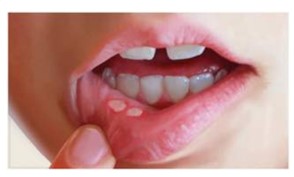
Fig. no. 1 Mouth ulcer
These sores are often painful and can make eating, drinking and speaking uncomfortable. Gels are mainly semi-solid formulations having a liquid phase that has been thickened with some other components. Topical gel preparation is used for the skin application or percutaneous penetration of medicaments or local action to certain mucosal surfaces. Mouth ulcers are small sores or an abrasion that develops in mouth or at the base of gum. Mouth ulcers are also known as canker sores or apt opus ulcer. A break or breach in the mucus membrane, that lines within the mouth is also recognized as a mouth ulcer. It generally arises as a yellow or white color depression in mouth. Mouth ulcers are usually generated by a number of causes, such as biting the inner layer of cheek, food allergies, hard teeth brushing, hormonal changes, vitamin deficiencies, bacterial infection and diseases.(4) Herbal mouth gel is a drug or preparation made from a plant and used for any to such purpose topical formulation is made up in a vehicle, or base, which may be optimized for a particular site of the body or the type of skin condition.
Classification of gels(2): -
- Single phase system
- Biphasic system
Properties of Gels(2): -
- The gelling agent must be inert, safe and cannot react with other constituents.
- The gelling agent should produce a functional solid-like nature at the time of storage which is easily broken when exposed to shear forces produced by squeezing the tube, trembling the bottle or at the time of topical application.
- It should have appropriate anti-microbial agent.
- The topical gel must not be gluey.
- The ophthalmic gel must be sterilized.
- The apparent viscosity or gel strength increase
- They exhibit the mechanical features of the solid state.
The active ingredients used in our formulation and evaluation are clove and myrrh.
CLOVE(5):
Clove are the aromatic flower bud of a tree in the family Myrtaceae, Syzygium Aromaticum. they are commonly used as a spice, flavoring or fragrance in consumer in product such as tooth paste, soaps, or cosmetics. This spice provides many nutrients that help in controlling sugar, reduce cholesterol and triglycerides, improve bone, liver and gastric health, reduce pain, reduce risk of heart disease and cancer, and is also good for oral health. Basically, it is known to have antimicrobial, anti-inflammatory, anti-oxidant activities and anti-bacterial, anti-fungal as well (1).
BENEFITS OF CLOVE(6): -
1. Lower inflammation
-shows anti-inflammatory properties
2. Fewer free radicals
-shows anti-oxidants properties
3. Reduced ulcer
-clove protect our stomach and mouth from ulcer
4. Improved liver function
is article guides a stepwise walkthrough by Experts for writing a successful journal or a research paper starting from inception of ideas till their publications. Research papers are highly recognized in scholar fraternity and form a core part of Ph
Objectives :-
- Collection of Plant Material.
- Extraction of Plant Material.
- Biological Evaluation of Antibacterial activity.
- Formulation of Herbal Mouth Gel using Extract.
- Evaluation of Herbal Mouth gel.
Ideal characteristics : -
- Must be anti-microbial, analgesics, anti-inflammatory, anti-bacterial.
- Treat mouth wounds, mouth ulcer, food burns and bleeding gums.
- Reduce burning sensation and swelling.
- Acts against microbes in mouth gives soothing effect and relieves pain.
- It should have smaller and moderate molecular weight.
- It should have ability to permeate the oral mucosal tissue
Clove(7)
- Plant name: Clove
- Synonyms: caryophyllum, clove flower, clove buds, lavang.
- Biological source: Clove consists of dried flower buds of Eugenia caryophyllus.
- Geographical source: it is indigenous to amboyna and Molucca islands. It is now cultivated chiefly in Zanzibar, Pemba, Penang, Madagascar, Cacrribean Islands, Srilanka and India. In India clove are grown in Nilgiri.
Taxonomical classification:
- Kingdom –Plantae
- Division – Magnoliophyta
- Class- Magnoliophyte
- Order – Myrtales
- Family – Myrtacae
- Genes – Syzygium
- Species – S. aromaticum
Chemical constituents:
clove contains about 15 to 20 % of volatile oil, 10% to 13% of tannins, resins, chromosome and eugenic. The volatile oil of the drug contain eugenol, eugenol acetate, caryophyllum and small quantities of esters, ketones and alcohols.
Parts used:
flower buds are used
Uses:
clove is used as a dental analgesic, carminatives, stimulant, flavouring agent, aromatic and antiseptic. It is also used in the preparation of cigarettes
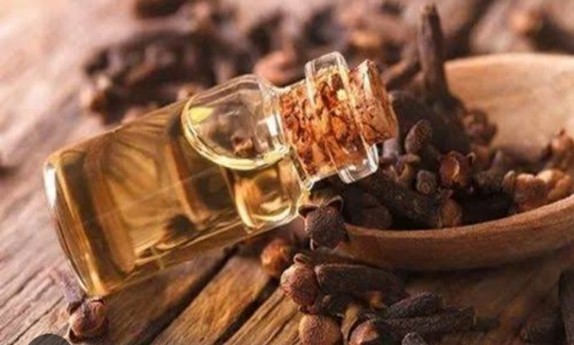
Fig. 2. Clove oil
Myrrh(7): -
- Plant name: Myrrh
- Synonyms: gum myrrh, bol, myrrha
- Biological source: Myrrh is an oleo gum resin obtained from Commiphora molmol engler and from other commiphora species. It belongs to family Burseraceae.
- Geographical source: it is found in north east Africa and southern Arabia.
Taxonomical classification:
-
- Kingdom – Plantae
- Class- Burseraceae
- Order – Burseraceae
- Family – Burseraceae
- Genius –Commiphora
- Species- Commiphora myrrh
Chemical Constituents:
Myrrh contains about 10% of yellowish thick volatile oil, 60% of gum, 25 to 40% of resin and bitter principle. It contains several impurities constituting about 5% of the drug. Resin contains ether soluble resin acids camphoric acids. The volatile oil contains terpenes, cuminic aldehyde, eugenol etc. the gum is associated with oxidase enzyme. It yields not more than 70% of alcohol insoluble matter.
Parts Used:
resins which is obtained from stem
Uses:
it is used as a stimulant and an antiseptic. It is also protective myrrh is astringent to the mucus membrane and hence its tincture is used in the mouth washes and gargles.
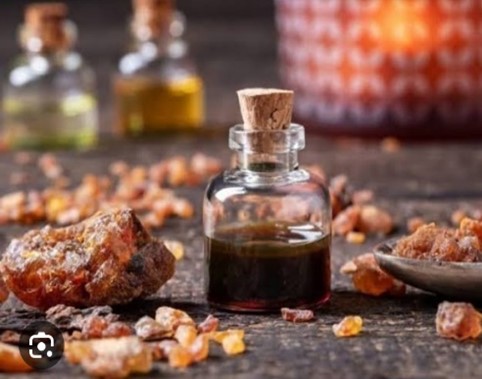
Fig 3. Crude Myrrh drug
MATERIAL AND METHOD
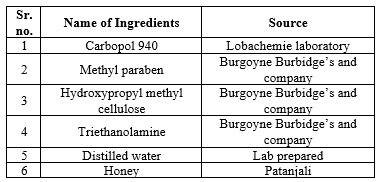
Table No 1 List Of Ingredient With There Source

Table No 2 List of Equipment’s
METHODOLOGY OF ISOLATION
Procedure:
Preparation of myrrh extract powder(3)
- Around 20 gram of myrrh was packed in a thimble and then put on soxhlet extractor.
- Under reflux methanol (90ml) was added in a distillation flask and heated for 6hr.
- After volume get decrease up to 20 ml it is transferred to the porcelain dish and kept it in hot air oven.
- After the complete evaporation of the solvent extract will be occur in the dried powder form. Using mortar and pestle the dried powder is converted into fine powder.
- Then extract powder is weight and used for the preparation of herbal mouth gel.
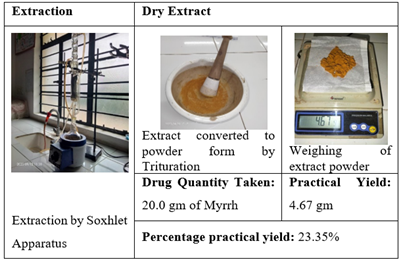
Table no. 4 Extraction of Myrrh powder preparation of gel base(8,9)
- Take 60 ml of distilled water in a beaker disperse specified amount of Carbopol 940 in it with continuous stirring by using magnetic stirrer.
- Kept the beaker aside to swell the Carbopol for half an hour
- Take another beaker add 5ml of distilled water in it with required quantity of methyl paraben and add it to the mixture of Carbopol
- Continuous stirring is done for the formation of gel base
- Triethanolamine is added to adjust the pH (6.8-7

Table no. 5: ingredients required for preparation of gel base
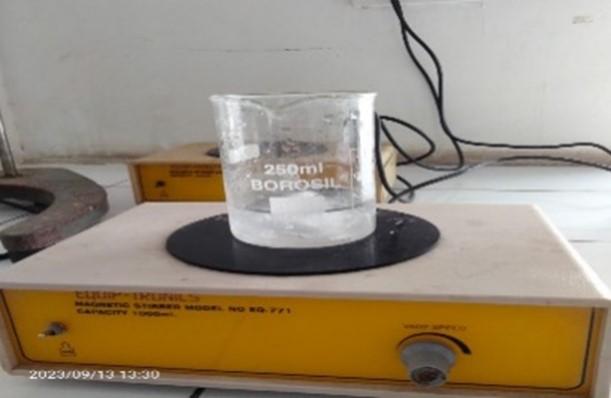
Fig. 4 Gel preparation by using Magnetic stirrer
Preparation of formulation (10,11)
- Take accurately amount of myrrh extract powder and clove oil in a Beaker and mixed them continuously using stirrer.
- Add this mixture to the weight amount of gel base.
- Stir it continuously until it forms homogenous mixture. Then add accurately weight measured amount of honey in it and mixed it continuously
- The product will be obtained from stirring vigorously. All the prepared gel formulation was subjected to evaluation test in order to select best formulation.
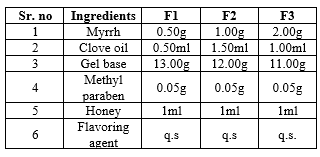
Table no. 6 preparation of formulation F1, F2, F3
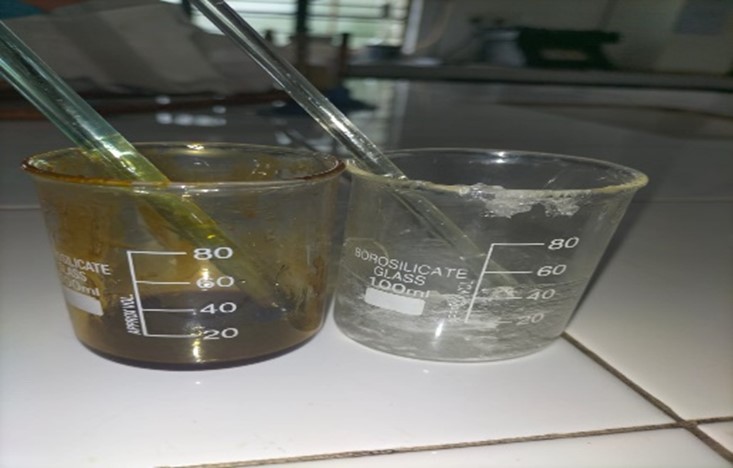
Fig. 5: Preparation of formulation
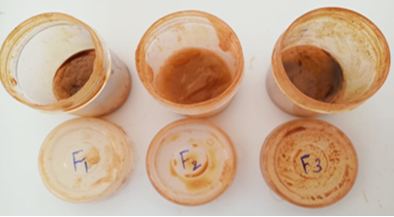
Fig.6: Mouth gel formulation F1, F2, F3
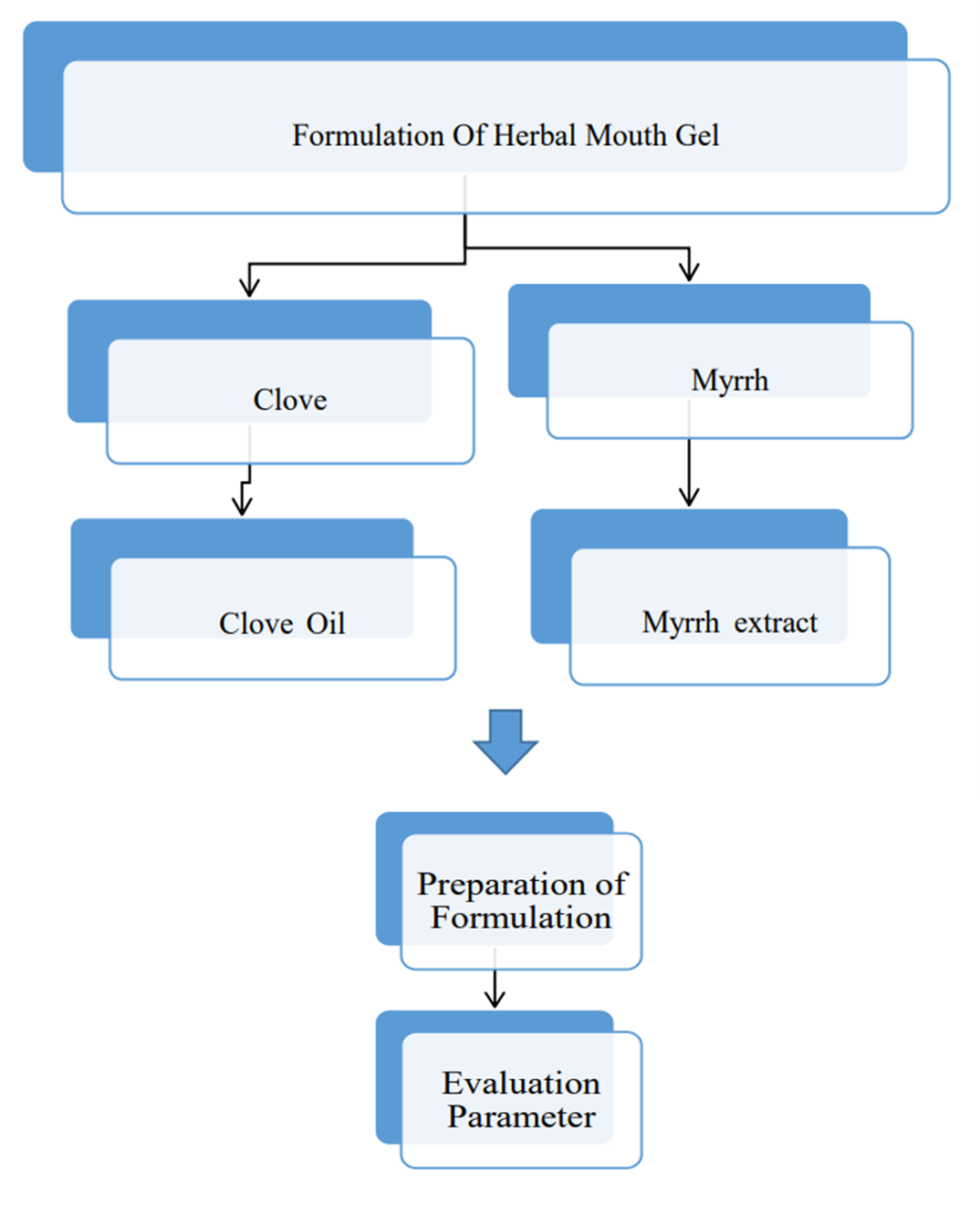
Flow chart for herbal mouth gel preparation
EVALUATION PARAMETER
- Physical Evaluation
- Color
- Odour
- State
- Consistency
- Homogeneity
- Measurement of pH(10)
The pH of gel was determined by using digital pH meter. Take 1 gm of gel and dissolved in 10 ml of distilled water and keep apart for two hours. Then the measurement of pH of formulation was done by dipping the glass electrode completely into the gel system three times and the average values are reported.
- Viscosity(12)
The measurement of viscosity of the formulated gel was determined by Viscometer with spindle no. 1 at 25°C. The gels were rotated at speed 0.3, 0.6 and 1.5 per minute and at each speed, the corresponding dial reading was noted. Then viscosity of the prepared gels was obtained by of the dial reading with factor given in the Viscometer catalogue.
- Clarity test(12)
The clarity of all the three batches was determined by visual inspection
- Antibacterial activity(13,14)
Prepare nutrient agar medium and sterillise by autoclave at 1210C for 15min. prepare the agar plates and label with the name of microorganisms inoculated using sterile technique, inoculate agar plates with their respective test microorganisms by swab streak method or spread plate method. Allow all culture plates to dry about 5min. using the sensi-disc dispenser apply the antibiotic discs by placing the dispenser over the agar surface. If dispenser are not available, distribute the individual discs at equal distance with sterile forceps. Gently press each discs down with the wooden end of a cotton swap or sterile forceps to ensure that the discs adhere to the surface of the agar. Incubate all plates in an inverted position at 370 C for 24-48 hours.
- Determination of Loss on Drying(15)
Weight about 1 gram of the powder drug into weighed flat and thin percaline dish. Dry in the oven at 1000 C until two consecutive weight do not differ by more than 0.5 mg. cool in the desicator and weigh. The loss in weight is usually recorded as moisture
RESULT
PHYSICAL EVALUAATION
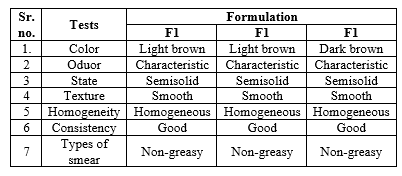
Table no.6: Physical evaluation
CLARITY TEST
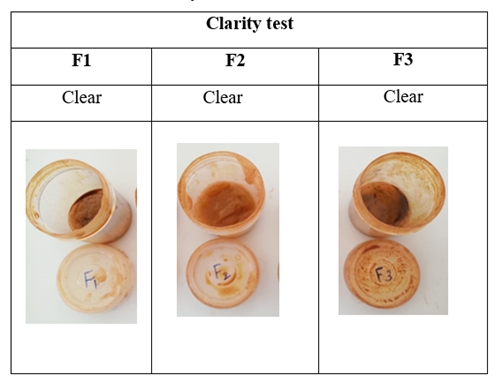
Table no. 7 clarity test of formulation F1,F2,F3
pH EVALUATION
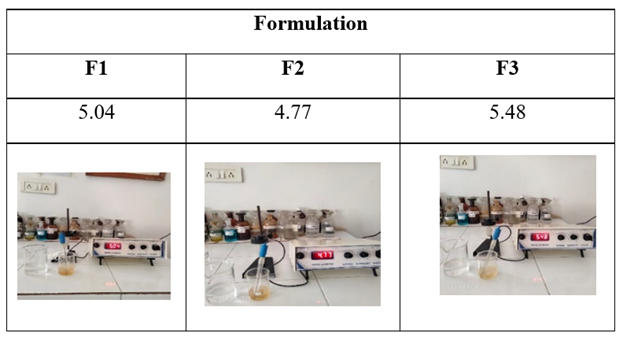
Table no.8: pH Evaluation
VISCOSITY

Table no. 9: viscosity of formulation F1, F2, F3
DETERMINATION OF LOSS ON DRYING
Calculation: weight of Porcelain Dish with sample
-
- F1= 29.07 + 1 = 30.07
- F2= 36.32 +1 = 37.32
- F3= 35.64 +1 = 36.64
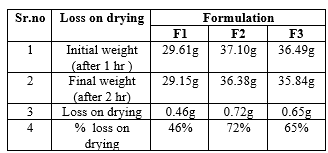
Table no. 10: Loss on drying and percentage loss on drying
ANTIBACTERIAL. ACTIVITY OF GEL FORMULATION
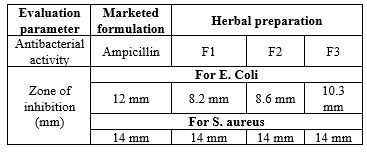
Table no.11: zone of inhibition in formulation f1, f2, f3
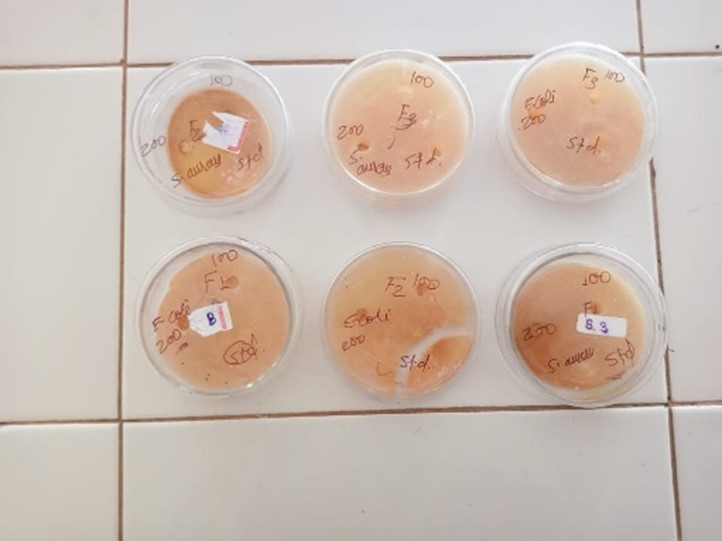
Fig.7:Zone of inhibition in F1, F2, F3
CONCLUSION
From the study it can be conducted that prepared Herbal mouth gel formulation F3 using myrrh and clove is suitable for the treatment of mouth ulcer and show better activities than Allopathy Gel. Hence it reduces the side effect as compared to Allopathy preparation and it does not show any harmful effect on the oral mucosa.
REFERENCES
- Herb use in treatment of mouth ulcer by Nikita Shahare, Shailendra Chouhan, G.N. Darwhekar in Department of Pharmaceutics international journal of Pharmacognosy and Chemestry 2(3),2021,pg 68-74
- Classification of gel https;//thepharmapedia.com/pharmaceutical-gel-pharmacy-notes/pharmacy-notes.
- Evaluation of Herbal Mouth Gel by Richa Singh, Sagar Bansal, and Manoj Kumar Mishra in International Journal of Drug Development and Research in 2020 vol.12 No. 2:150
- Antimicrobial activity of Yemeni myrrh by Sadik Almekhlafi, Anes A.M. Thabit, Ameen M.I. Alwossabi, Nasser Awadth, Abdulbaqi A.M. Thabet and Zaid Algaadari in ISSN 0975-7384 Journal of Chemical and Pharmaceutical Research, 2014,6(5):1006-1013
- Variousenefits of Clove by Mayank Agrawal, Sonam Agrawal, Dr. Radhika Rastogi in ISSN 2321-5674 indian journal of Research and Biotechnology.
- Pharmacognostical study of Clove by Shahid Hussain, Rafia Rahman and Ayesha Mushtaq in ISSN 2226-9614 International Journal of Chemical and Biochemical Science.
- Plant profile of Clove And Myrrh from Pharmacognosy book of Nirali Prakashan by C.K. Kokate, A.P. Purohit , S.B. Gokhale for Clove refer pg. no. 14.85-14.87, and for Myrrh refer pg no. 14.144-14.145.
- Preparation OF Gel Base By Mohsin J. Jamadar, Rajmahammad Husen Shaikh in Journal Of Pharmaceutical Research and Education (2), 201-24, 2017
- Safety assessment of triethanolamine and triethanolamine-containing ingredients as used in cosmetics Monice M Fiume, Bart Heldreth, Wilma F Bergfeld, Donald V Belsito, Ronald A Hill, Curtis D Klaassen, Daniel Liebler, James G Marks Jr, Ronald C Shank, Thomas J Slaga, Paul W Snyder, F Alan Andersen International journal Application of carbopol 940 in gel.
- Formulation and Evaluation of herbal gel for management of mouth ulcers Kanchan Upadhye, Kirti Charde, Gouri Dixit, Suparna Bakhle Indian J Pharm Pharmacol 8 (3), 226-230, 2021
- Formulation and Evaluation of Herbal Oral Gel Containing Extracts of Powdered Psidium guajava Linn Leaves with Curcuma longa Linn Rhizomes to Treat Mouth Ulcer Richa Sing*, Sagar Bansal and Manoj Kumar Mishra Vol.12 No.2:150
- Herbal Mouth Ulcer Gel: A Review By Ms. Vani Madaan*, Ms. T. Manjula Journal of Fundamental & Comparative Research Vol. VIII, No. 1(XVI) : 2022 ISSN: 2277-7067
- Pharmaceutical Microbiology Experiments and techniques By Dr. Chandrakant Kokare Third edition pg no. 68.
- Pharmaceutical Microbiology Experiments and techniques By Dr. Chandrakant Kokare Third edition pg no. 145.
- Practical Pharmacognosy 24th Edition ISBN NO. 978-81-85790-30-5 by Dr. K. R. Khandelwal and Dr. Vrunda K. Sethi Pg No. 23.7


 Ankit P. Gondane *
Ankit P. Gondane *



















 10.5281/zenodo.10964940
10.5281/zenodo.10964940